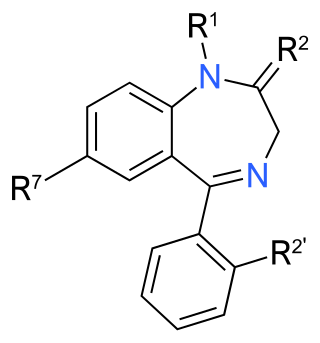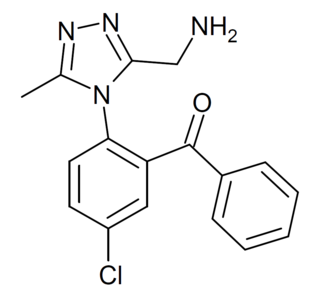
Alprazolam, sold under the brand name Xanax among others, is a fast-acting, potent tranquilizer of moderate duration within the triazolobenzodiazepine group of chemicals called benzodiazepines. Alprazolam is most commonly prescribed in the management of anxiety disorders, especially panic disorder and generalized anxiety disorder (GAD). Other uses include the treatment of chemotherapy-induced nausea, together with other treatments. GAD improvement occurs generally within a week. Alprazolam is generally taken orally.

Avizafone (Pro-Diazepam) is a water-soluble prodrug of the benzodiazepine derivative diazepam. It can be administered intramuscularly.

Adinazolam is a tranquilizer of the triazolobenzodiazepine (TBZD) class, which are benzodiazepines (BZDs) fused with a triazole ring. It possesses anxiolytic, anticonvulsant, sedative, and antidepressant properties. Adinazolam was developed by Jackson B. Hester, who was seeking to enhance the antidepressant properties of alprazolam, which he also developed. Adinazolam was never FDA approved and never made available to the public market; however, it has been sold as a designer drug.

Rilmazafone is a water-soluble prodrug developed in Japan. Inside the human body, rilmazafone is converted into several benzodiazepine metabolites that have sedative and hypnotic effects.

Meclonazepam ((S)-3-methylclonazepam) was discovered by a team at Hoffmann-La Roche in the 1970s and is a drug which is a benzodiazepine derivative similar in structure to clonazepam. It has sedative and anxiolytic actions like those of other benzodiazepines, and also has anti-parasitic effects against the parasitic worm Schistosoma mansoni.

Benzodiazepine overdose describes the ingestion of one of the drugs in the benzodiazepine class in quantities greater than are recommended or generally practiced. The most common symptoms of overdose include central nervous system (CNS) depression, impaired balance, ataxia, and slurred speech. Severe symptoms include coma and respiratory depression. Supportive care is the mainstay of treatment of benzodiazepine overdose. There is an antidote, flumazenil, but its use is controversial.

Benzodiazepine use disorder (BUD), also called misuse or abuse, is the use of benzodiazepines without a prescription and/or for recreational purposes, which poses risks of dependence, withdrawal and other long-term effects. Benzodiazepines are one of the more common prescription drugs used recreationally. When used recreationally benzodiazepines are usually administered orally but sometimes they are taken intranasally or intravenously. Recreational use produces effects similar to alcohol intoxication.

N-Desalkylflurazepam is a benzodiazepine analog and an active metabolite of several other benzodiazepine drugs including flurazepam, flutoprazepam, fludiazepam, midazolam, flutazolam, quazepam, and ethyl loflazepate. It is long-acting, prone to accumulation, and binds unselectively to the various benzodiazepine receptor subtypes. It has been sold as a designer drug from 2016 onward.

Pyrazolam (SH-I-04) is a benzodiazepine derivative originally developed by a team led by Leo Sternbach at Hoffman-La Roche in the 1970s. It has since been "rediscovered" and sold as a designer drug since 2012.

Diclazepam (Ro5-3448), also known as chlorodiazepam and 2'-chloro-diazepam, is a benzodiazepine and functional analog of diazepam. It was first synthesized by Leo Sternbach and his team at Hoffman-La Roche in 1960. It is not currently approved for use as a medication, but rather sold as an unscheduled substance. Efficacy and safety have not been tested in humans.

Flubromazepam is a benzodiazepine derivative which was first synthesized in 1960, but was never marketed and did not receive any further attention or study until late 2012 when it appeared on the grey market as a novel designer drug.

Clonazolam is a drug of the triazolobenzodiazepine (TBZD) class, which are benzodiazepines (BZDs) fused with a triazole ring. Although little research has been done about its effects and metabolism, it is sold online as a designer drug.

Flubromazolam (JYI-73) is a triazolobenzodiazepine (TBZD), which are benzodiazepine (BZD) derivatives. Flubromazolam is reputed to be highly potent, and concerns have been raised that clonazolam and flubromazolam in particular may pose comparatively higher risks than other designer benzodiazepines, due to their ability to produce strong sedation and amnesia at oral doses of as little as 0.5 mg. Life-threatening adverse reactions have been observed at doses of only 3 mg of flubromazolam.

Bromazolam (XLI-268) is a triazolobenzodiazepine (TBZD) which was first synthesised in 1976, but was never marketed. It has subsequently been sold as a designer drug, first being definitively identified by the EMCDDA in Sweden in 2016. It is the bromo instead of chloro analogue of alprazolam and has similar sedative and anxiolytic effects to it and other benzodiazepines. Bromazolam is a non subtype selective agonist at the benzodiazepine site of GABAA receptors, with a binding affinity of 2.81 nM at the α1 subtype, 0.69 nM at α2 and 0.62 nM at α5. The "common" dosage range for users of bromazolam was reported to be 1–2 mg, suggesting its potency is similar to alprazolam.

Flualprazolam is a tranquilizer of the triazolobenzodiazepine (TBZD) class, which are benzodiazepines (BZDs) fused with a triazole ring. It was first synthesised in 1976, but was never marketed. It can be seen as the triazolo version of fludiazepam. It has subsequently been sold as a designer drug, first being definitively identified as such in Sweden in 2018. It can be described as the 2'-fluoro derivative of alprazolam or the fluoro instead of chloro analogue of triazolam, and has similar sedative and anxiolytic effects.

Nitemazepam is a benzodiazepine derivative which was first synthesised in the 1970s but was never marketed. It is the 7-nitro instead of 7-chloro analogue of temazepam, and also the 3-hydroxy derivative of nimetazepam, and an active metabolite. It has in more recent years been sold as a designer drug, first being definitively identified in Europe in 2017. It is metabolized to 7-aminonitemazepam, nimetazepam, 3-hydroxynitemazepam, temazepam, and nimetazepam glucuronide.

Phenazolam, is a benzodiazepine derivative which acts as a potent sedative and hypnotic drug. It was first invented in the early 1980s, but was never developed for medical use. It has been sold over the internet as a designer drug, first being identified in seized samples by a laboratory in Sweden in March 2016.

Alprazolam triazolobenzophenone is a chemical compound that is a prodrug for the benzodiazepine derivative alprazolam. At neutral pH it readily cyclizes to alprazolam, while in acidic conditions alprazolam undergoes a ring-opening reaction back to the ketone. A series of related acyl derivatives was researched in the 1980s as injectable water-soluble prodrugs of alprazolam, but were never developed for medical use. Subsequently, this compound has been detected as a designer drug, first being identified from a seizure in Spain in March 2014.
Synthetic drugs refer to substances that are artificially modified from naturally-occurring drugs and are capable of exhibiting both therapeutic and psychoactive effects.


















